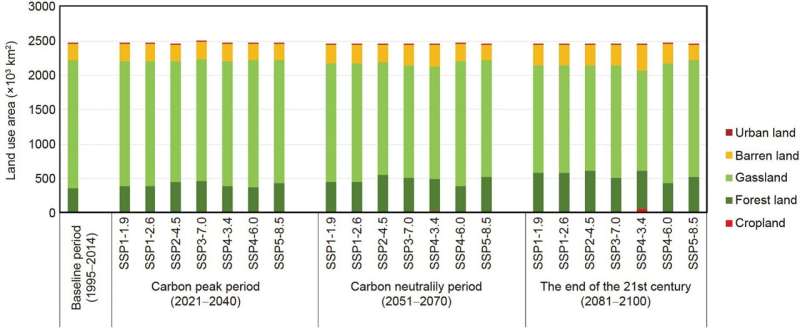This article has been reviewed according to Science X's editorial process and policies. Editors have highlighted the following attributes while ensuring the content's credibility:
fact-checked
peer-reviewed publication
trusted source
proofread
Study estimates land use changes in the Qinghai-Tibet Plateau

Land use change is closely related to human activities, affecting ecological environment and species diversity, and how to make scientific observations and simulations to predict it has become a focal issue.
The Qinghai-Tibet Plateau, known as the "third pole of the world," is extremely sensitive to global climate change. Its complex physical geography and unique social and human processes have made it a hot spot for global research. Land use change on the Tibetan Plateau is an important foundation of ecological security barrier, and it has significant impacts on the Tibetan Plateau, its surrounding regions and the world.
This study predicts land use changes in the Tibetan Plateau during the carbon peak (2021-2040), carbon neutral (2051-2070), and late 21st century (2081-2100) based on shared socioeconomic pathways (SSPs). In the base period (1995~2014), the areas of arable land, forest land, grassland, urban land and bare land on the Tibetan Plateau are about 14×103, 349×103, 1853×103, 0.3×103 and 235×103km2, respectively.
Compared with the base period, the area of grassland will decrease in the next three periods, and urban, forest land and bare land will increase. By the end of the 21st century, grassland will decrease by 6.1 to 21.7%, and woodland is the land use type with the largest increase in area, increasing by about 21.2 to 72.8%.
The work is published in the journal Science China Earth Sciences.
More information: Runhong Xu et al, Projected land use changes in the Qinghai-Tibet Plateau at the carbon peak and carbon neutrality targets, Science China Earth Sciences (2023). DOI: 10.1007/s11430-022-1077-y
Journal information: Science China Earth Sciences
Provided by Science China Press




















